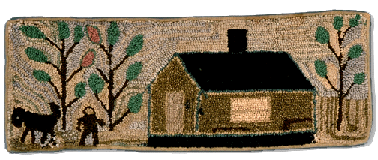
Dyes
Nineteenth-century Canadian rugs were generally monochromatic because of the fabrics used. Basic materials consisted of recycled fibres — clothing scraps or old woollens. At the turn of the century, materials became more sophisticated and hookers were more prone to use wool, new fibres, and the new materials created by the textile industry. The choice of colours increased, with more subtle, rich, and complex hues. After the Second World War, synthetic fibres became far more popular and were integrated into the range of materials employed.
Artists used all sorts of plants, roots, and bark to create fabric dyes. These natural dyeing techniques rapidly declined around the 1920s with the arrival of chemical dyes, which made it possible to further extend the range of colours.
In preparing dyes, artists chose plants that would render the desired colours, varying the intensity of tones by skilfully adjusting proportions.

The following plants are used for natural dyes:
| alder | black |
| beet | red |
| hemlock bark | brown |
| indigo | blue |
| red onion peel | beige |
| yellow onion peel | yellow |
| carrot tops, plantain | green |
| leaves pale | green |
| stems dark | green |
| tea leaves | brown |
| strong coffee | brown |
DESIGN AND AESTHETICS
aesthetics | dyes
welcome | introduction | background | rug hooking | demonstrations | design | rugs





